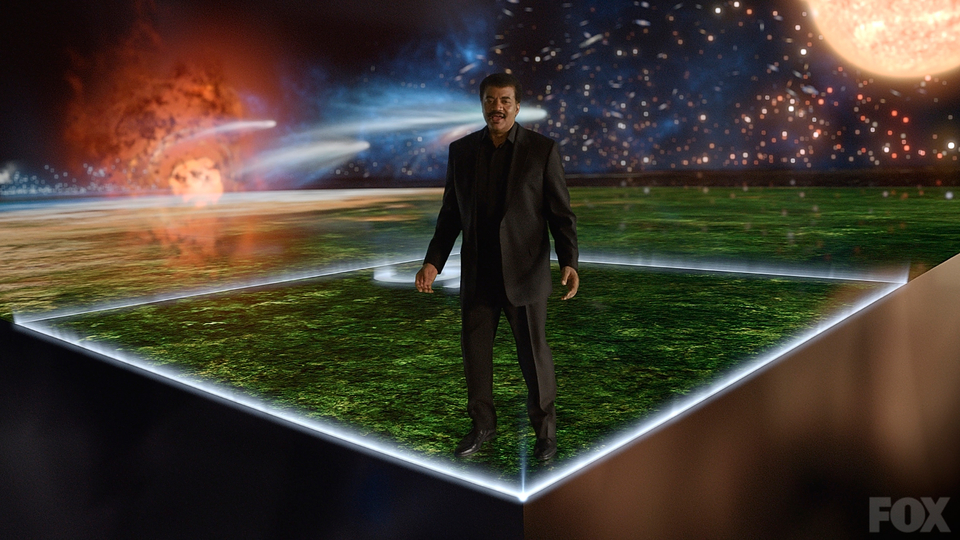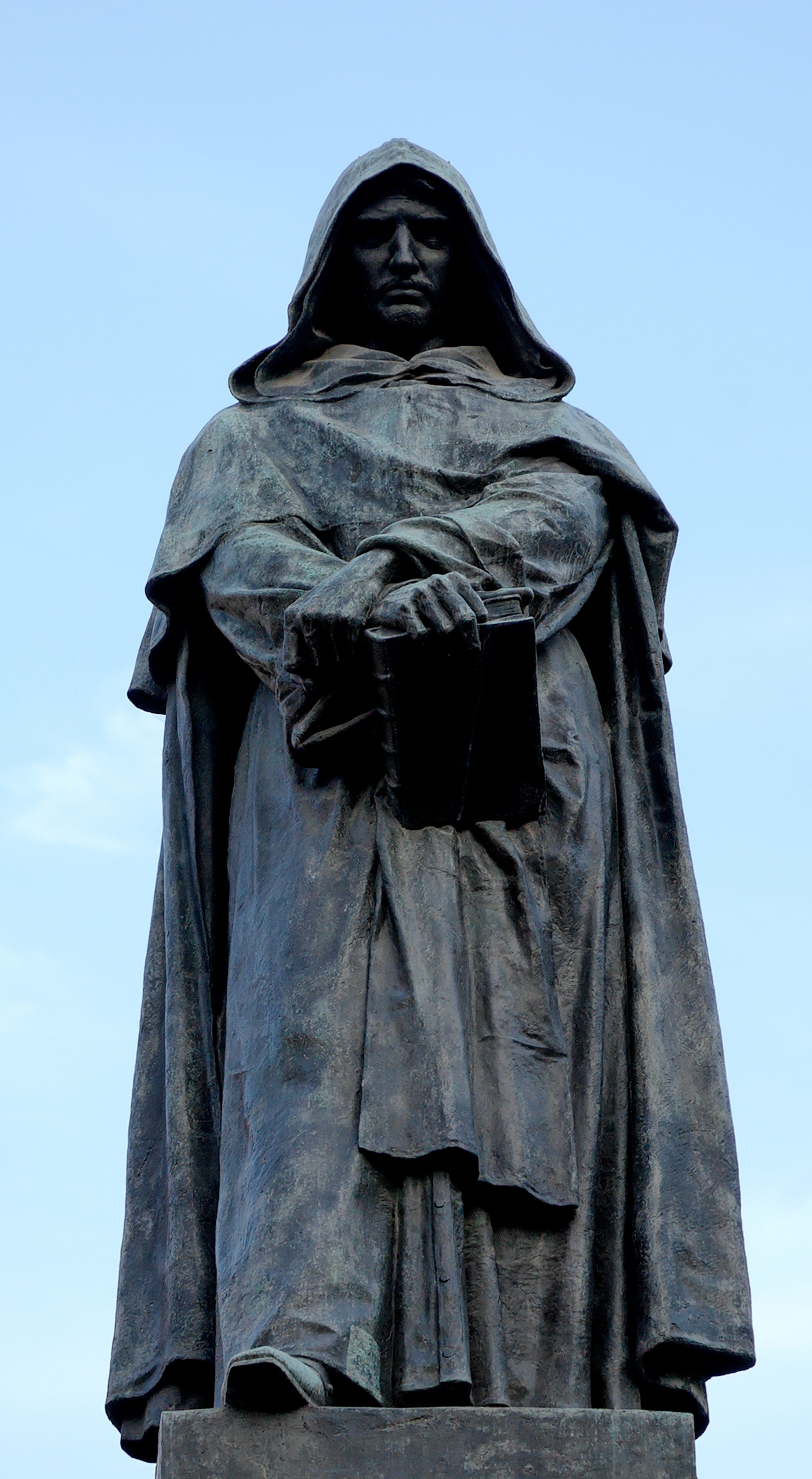 |
| The Cosmic Calendar makes its return (cosmosontv.com) |
The premiere of Cosmos was stunningly gorgeous and a great introduction to what I hope is the format for the series: A whirlwind tour of the scientific subject at hand using the Ship of the Imagination and flashy visual effects coupled with an animated story about a weekly "hero" story from the past. Seth MacFarlane and Ann Druyan, the executive producers, have said that the show is aimed at people who never knew they had an interest in science, and the flashy style of the presentation certainly shows that entertainment is a top priority, but even for someone like me (who obviously is already pretty far down the rabbit hole) there was something new, interesting, and provocative on this first episode alone. After a quick look at everything from the scale of the Earth and up, I'm already anxious for the next episode, which looks to be another jaw-dropping romp, this time of the tiny, inner universe between the wisps of our upper atmosphere and the dark bottoms of our oceans.
To bide my time and keep myself from watching all the previews and sneak peeks and spoiling it all, I think I'll publish a quick look each week at the latest episode. I'll try and highlight something I thought was inaccurate (Nitpicks), something I was glad to see in the show (Nods), and something I learned (News). If I can't find something for a category on a given week, then I get to rant a little! Sounds fair? OK, let's get started.
Nitpicks
First of all, let me say that I want to approach this section with the following attitude: I understand that in order to be entertaining and to fit within the time slot, there will have to be some artistic license taken with depictions of certain phenomena. The Universe does not owe us that each little piece of it fits neatly onto our TV screens!
In my opinion, the overcrowded presentation of the Asteroid Belt and Kuiper Belt is the best example of this. Probably most people are familiar with the idea of an asteroid belt from Star Wars. After escaping Hoth, with Imperial ships hot on their tail, Han Solo and the gang steer the Millenium Falcon into an asteroid field in a desperate gamble to try and shake the pursuit. In a classic Hollywood science babble line, C-3PO (ever the worrier) sums up the situation for Han (clip):
"Sir! The possibility of successfully navigating an asteroid field is approximately 3,720 to 1!"
To which the daring rogue retorts, "Never tell me the odds!"
What gall! Except that the odds are, at the very worst, probably closer to flipped. That is, it's highly unlikely that even the giant capital ships on their tail would even notice even a single large asteroid on a trip through a belt like ours unless they were looking very carefully. That's a far cry from having to dodge and weave inches from countless tumbling death rocks like we saw in the movie.
The fact is that, while there are most likely billions of asteroids larger than about 10 m that reside in the belt, the belt itself is so ridiculously huge (It's a donut with a thickness of about 1 au, or Earth-Sun distance, and a radius of about 3 au) that each asteroid has, on average, about 4 times the volume of Jupiter to itself. If you were one 10+ meter asteroid, sitting at your computer on Earth, the next one would be about halfway to the Moon!
In fact, if you flew a star destroyer (about 5 km long! Update: nope, just a mile long, thanks +Casey Handmer for correcting, later numbers corrected) through our asteroid belt with the flat side facing the direction of the incoming asteroids, you could expect to fly through our asteroid belt over 10 million times and only have to dodge a single 10+ meter asteroid. So a better picture of the asteroid belt would be empty space, but that's quite boring. I can't really blame Cosmos for using the crowded model they did, though, because aren't you glad you got to learn something else?
In fact, if you flew a star destroyer (about 5 km long! Update: nope, just a mile long, thanks +Casey Handmer for correcting, later numbers corrected) through our asteroid belt with the flat side facing the direction of the incoming asteroids, you could expect to fly through our asteroid belt over 10 million times and only have to dodge a single 10+ meter asteroid. So a better picture of the asteroid belt would be empty space, but that's quite boring. I can't really blame Cosmos for using the crowded model they did, though, because aren't you glad you got to learn something else?
Nods
I was very pleased with the cosmic calendar year as it was presented this time around (see title picture). The amount of time between the Big Bang and today is 13.8 billion years. The show compresses that onto a calendar year and shrinks other timescales appropriately (if the Big Bang is on January 1st and the Sun is born on August 31st, the first flowers bloomed 4 days ago!). To compare that length of time to our own lives always reveals some crazy results. I loved when Tyson pointed out that every story you've ever been told happened in the last 14 seconds, and that the scientific method has only been around about 1 second, which spans the time from Galileo's discovery of mountains on the Moon to Neil Armstrong's footprints in the Sea of Tranquility. One thing I wish they had mentioned is that on the cosmic calendar 100 years, an entire lifetime, is a quarter of a second. Literally the blink of a cosmic eye. It's things like this that show us why people like Richard Dawkins and Carl Sagan speak of the poetry of science.
News
 |
| The statue of Giordano Bruno stands in the square in Rome where he was burnt for heresy. The statue is set facing the Vatican. (Wiki) |
The tragedy of Giordano Bruno was wonderfully told in the Archer-esque animation style that the series will be using for these segments. I was totally unfamiliar with Bruno's incredibly lucky guess regarding the (effective) infinitude of stars and planets like our Sun and Earth, as well as with his horrible fate at the hands of the Inquisition. Some people will take exception to the ominous, dark style of the animation when it came to Church officials, and already several articles claim that the show is merely anti-religious propaganda. However, one thing that I think they're forgetting is that Bruno, the hero of the piece, was himself so religiously devoted that he would rather die than recant his vision of an infinite universe and an infinite god. Tyson makes plain after the execution scene that Bruno was no scientist, lacking evidence and basing his claims in theology rather than astronomy, so why feature his story in a show about science?
The message I took away was not that Cosmos hates religion, but that Cosmos is painting a picture of the world in which there is no ultimate authority among us which should silence dissent. "Question everything" was one of the conditions to joining the voyage through the cosmos that Tyson laid out plainly in the opening sequence of the show. The show accepts Bruno's theories, and I would argue it also accepts the medieval Church's geocentric theories, but not as truth, merely as ideas to hold up to the scrutiny of investigation and comparison with reality.
What the Inquisition did in this era was not a necessary consequence of religion (thought it is a frighteningly common outcome), but rather one dark, fearful road down which the faithful may travel. Bruno's final words to his inquisitor were "Perchance you who pronounce my sentence are in greater fear than I who receive it." This profound line comes from a man who has had eight years to contemplate his imprisonment for heresy, and its meaning is perfectly in line with the message of the story: The Church was afraid of losing its unquestioned authority over all matters of importance, and hence was hostile to all those who questioned the fundamental underpinnings of the faith. Bruno recognized that his tormentors were more afraid of him than he was of them, and Cosmos wants us to know that there is no certainty, that everything is open to question and doubt. Those who claim certainty must be frightened of those who spread doubt, and so the comfort of certainty, of unyielding faith, is only a mask to hide a deeper fear. Science offers us a way to embrace uncertainty, to revel in mystery, and to build on our abilities to understand and reason so that we may solve the next puzzle.
"Believe those who seek the truth, doubt those who find it." - André Gide

No comments:
Post a Comment